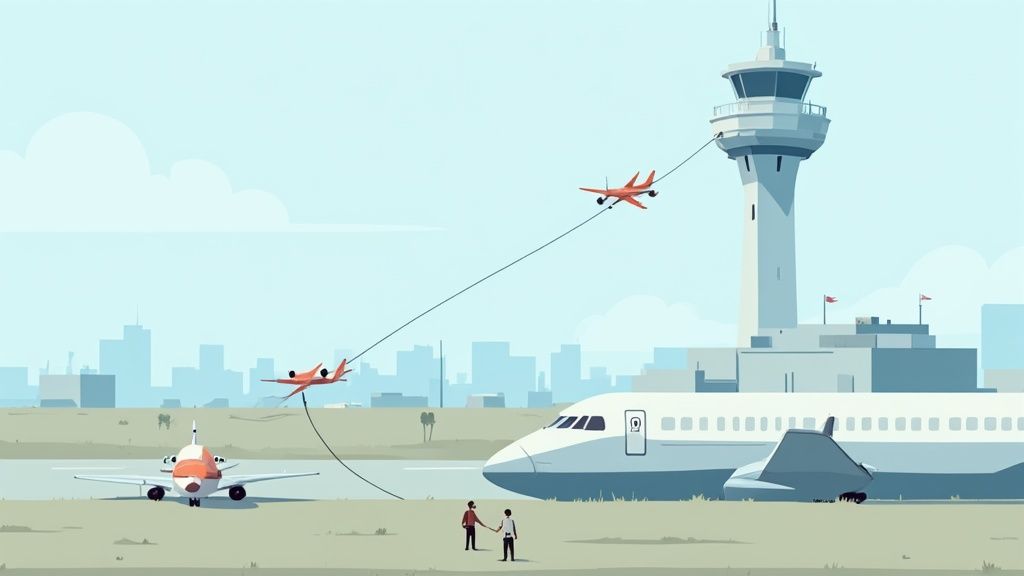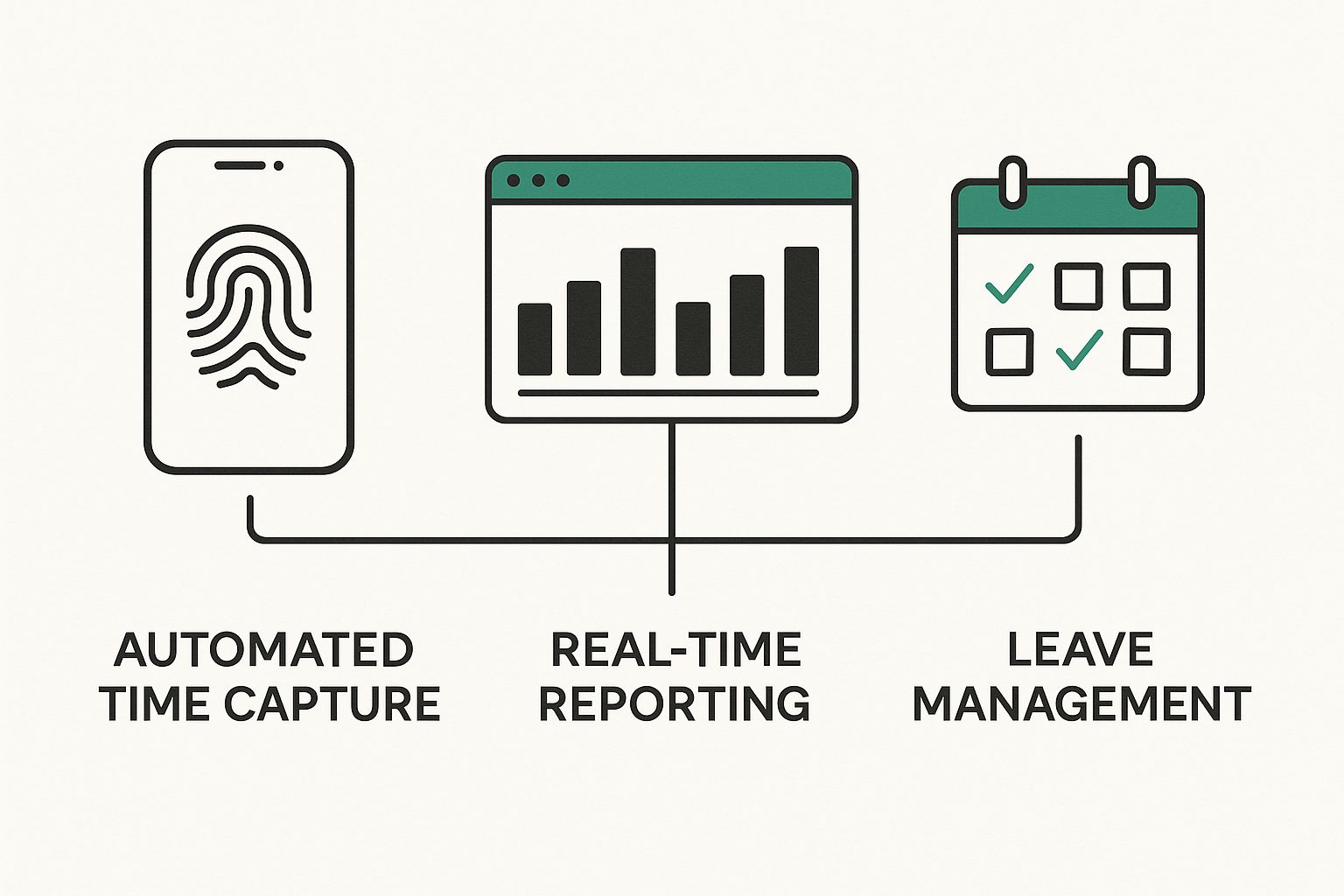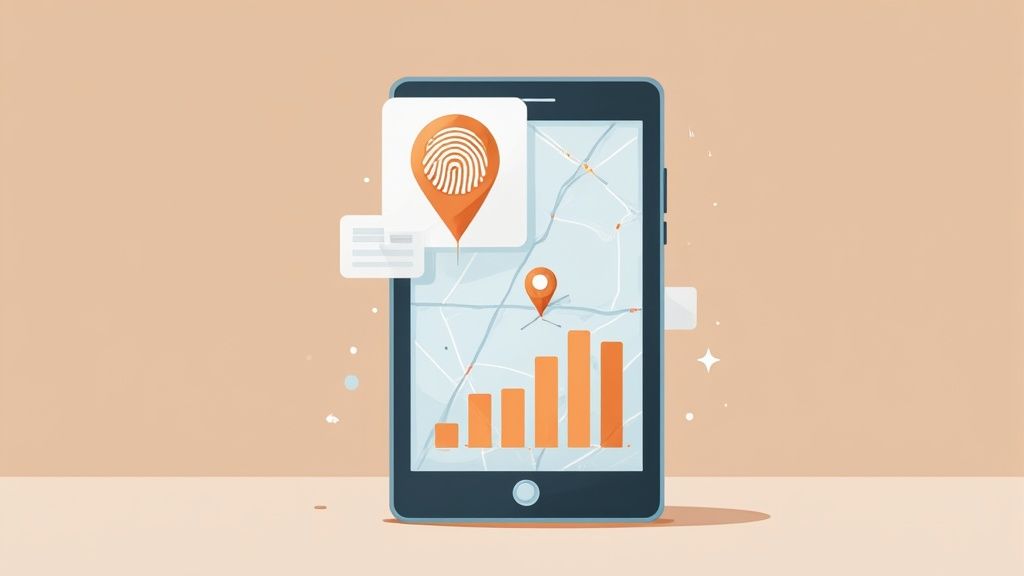
Top Employee Attendance Tracking Software for Your Business
Posted by Robin on 12 Oct, 2025 in
Remember the days of paper timesheets and punch clocks? It wasn't that long ago that tracking when people started and finished work was a purely manual job. This old-school approach was not just time-consuming; it was riddled with potential for human error, costing businesses a fortune in administrative overheads and payroll mistakes.
Employee attendance tracking software is the modern answer to this age-old problem. It’s a digital tool designed to automate the entire process, giving you real-time data on who’s working, when they're working, and for how long.
What Is Employee Attendance Tracking Software?

Think about trying to manage an airport with nothing but handwritten notes. The chaos would be unimaginable. Delays, mix-ups, and massive errors would be the norm. Yet, that's exactly what many businesses are doing when they rely on spreadsheets or paper to track their team's attendance.
Modern attendance software acts as the air traffic control for your workforce. It provides a clear, live, and accurate picture of your most valuable asset: your people. We’ve come a long way from clunky spreadsheets and the risk of "buddy punching," where one employee clocks in for another. Today's solutions are smart, cloud-based platforms that bring all your attendance data into one central hub.
The Core Purpose of Attendance Software
At its heart, this software is built to answer crucial operational questions quickly and accurately. It’s about more than just logging hours; it’s about providing the insights you need to make better business decisions.
Here's what it really does:
- Automates Time Capture: It accurately logs clock-in and clock-out times, breaks, and overtime without anyone needing to lift a finger.
- Ensures Payroll Accuracy: By integrating directly with your payroll system, it makes sure everyone gets paid correctly for the exact hours they’ve worked. No more guesswork.
- Optimises Resource Allocation: Managers get a live view of who is available, which helps prevent scheduling clashes and ensures you always have the right people on deck.
- Maintains Compliance: It creates a foolproof digital record, helping you stick to complex labour laws and working time regulations without the headache.
A study once highlighted that businesses lose a shocking amount of money each year to time theft and payroll errors, with manual methods being the main culprit. Switching to an automated system can slash these payroll inaccuracies by over 80%.
From Manual Chore to Strategic Asset
Moving to an automated system is a game-changer. It transforms attendance tracking from a tedious administrative task into a proactive, strategic part of your business.
Instead of chasing down missing timesheets or manually tallying up hours, managers can now spend their time analysing attendance patterns. Are certain teams showing signs of burnout? Is absenteeism becoming an issue in one department? This data-driven approach allows for smarter decision-making, turning a simple operational necessity into a powerful tool for optimising your workforce and driving real growth.
Key Benefits of Tracking Employee Attendance
Switching to an automated system for tracking attendance isn't just about modernising an old-school process; it's about getting real, measurable results that directly help your bottom line. When you ditch the unreliable spreadsheets, you start seeing significant cost savings, clearer insights into your operations, and a much more proactive way of managing your team.
One of the most immediate wins is a massive drop in payroll errors. Let's be honest, manual data entry is a magnet for mistakes that can lead to overpayments (costing you money) or underpayments (damaging trust). Automating this ensures payroll is spot on every single time, based on precise, verified data. Just think of all the admin hours saved from chasing timesheets and fixing mistakes.
Gain Deeper Financial Control
Accurate attendance data gives you a crystal-clear picture of your labour costs. You can see exactly where your team's hours are going—whether it's across different projects, departments, or even specific client accounts. This level of detail is gold for accurate budgeting and forecasting, letting you manage your resources much more effectively.
Good attendance tracking also gives you a better handle on the overall health of your workforce. It provides vital data points that help with understanding employee turnover rates, a key metric for any stable business.
For example, a retail business can compare attendance data against sales figures. This helps them tweak shift patterns, making sure they’ve got enough staff during busy spells without wasting money on labour during the quiet times.
The market certainly reflects this need for better control. The global time and attendance software market was valued at $3.1 billion back in 2022, a number driven by the growing complexities of how we all work. Here in the UK, more and more companies are using these systems to get a real-time view of what's happening, which slashes payroll mistakes and makes HR operations run a lot smoother.
Proactively Manage Absenteeism
When you consistently track attendance, you start spotting patterns before they snowball into major issues. A reliable system will flag trends like frequent short-term absences or repeated lateness in a particular team, giving managers a heads-up to step in early.
Instead of just reacting when things go wrong, you can have supportive, data-backed conversations with your employees. This proactive approach helps you get to the root of any problems, improve employee well-being, and keep productivity on track. For a closer look, check out the key benefits of absence management software for SMEs.
On top of that, effective employee attendance tracking software makes staying compliant with legal and regulatory rules much easier. It creates an accurate, indisputable digital record of all hours worked. This is essential for sticking to complex working time regulations and protecting your business from potential disputes, ensuring everyone is treated fairly.
Essential Features Your Software Must Have
Choosing employee attendance tracking software can feel a bit like navigating a maze. With so many options, bells, and whistles, it’s easy to get lost. The best approach? Cut through the noise and focus on the non-negotiable features that form the backbone of any solid system.
Think of it like building a house. You wouldn't pick out curtains before you have the foundations and walls in place. It's the same with software. You absolutely must have the basics mastered—time capture, reporting, leave management, and payroll integration—before any of the fancy add-ons will do you any good.
Automated Time Capture
First and foremost, the software has to automatically and accurately log when your team starts and stops work. Let's be honest, manual timesheets are a relic of the past, riddled with human error and open to things like "buddy punching." Modern software puts a stop to all that.
You'll want a system that gives your team a few different ways to clock in and out, because one size rarely fits all:
- Mobile Apps: An absolute must for remote, hybrid, or field-based staff. They can log hours from their smartphones, wherever they are.
- Web-Based Clock-In: A straightforward option for office-based employees who can clock in right from their computers.
- Biometric Systems: For workplaces needing tighter security, fingerprint or facial recognition scanners offer foolproof attendance records.
This infographic neatly shows how these key features work together to create a reliable workforce management system.

As you can see, it's the combination of these core functions that delivers a truly complete and dependable solution.
Real-Time Reporting and Dashboards
Once you’re collecting all this accurate data, you need to be able to see it in a way that actually makes sense. That's where a real-time reporting dashboard comes in. It gives managers an instant snapshot of who’s working, who’s on a break, and who’s off.
This isn’t about playing Big Brother; it's about having operational awareness. A live dashboard empowers managers to make smart, quick decisions—like reassigning tasks to cover an unexpected absence or approving overtime to handle a sudden rush.
Integrated Leave Management
Trying to manage holiday requests, sick days, and other types of leave through a messy inbox or a clunky spreadsheet is a recipe for chaos. A top-tier employee attendance tracking software must have leave management built right in.
This feature lets employees submit their time-off requests directly through the platform. Managers get a notification and can approve or decline with a click. Everything automatically updates the central calendar and timesheets, which means no more scheduling headaches or double bookings.
Seamless Payroll Integration
Finally, and this is a big one, the whole system has to talk to your payroll process without any friction. Manually typing hours from a timesheet into your payroll software is just asking for trouble. It leads to expensive mistakes and, understandably, unhappy employees.
A critical feature is direct integration with popular payroll platforms. This ensures that as soon as timesheets are approved, the data flows automatically and accurately into your payroll system. It doesn’t just save you countless hours of admin; it guarantees your team gets paid correctly and on time, every single month.
Essential vs Advanced Software Features
When you're starting out, it's crucial to distinguish between what you absolutely need right now and what would be nice to have later. This table helps you prioritise features, focusing on the essentials first while keeping an eye on advanced capabilities for future growth.
| Feature Category | Essential Feature (Must-Have) | Advanced Feature (Good-to-Have) |
|---|---|---|
| Time Capture | Mobile & Web Clock-In/Out | Geofencing & Biometric Scanners |
| Reporting | Real-Time Dashboards & Basic Reports | Customisable Analytics & Trend Forecasting |
| Leave Management | Request & Approval Workflow | Automated Accrual Policies & Custom Leave Types |
| Payroll | Direct Integration with Major Platforms | Automated Overtime & Pay Rate Calculations |
| Scheduling | Basic Calendar & Rota Views | AI-Powered Shift Planning & Optimisation |
Focusing on the "Must-Have" column ensures you build a strong foundation. The "Good-to-Have" features can then be added as your business scales and your needs become more complex, giving you a clear upgrade path.
Taking Your Tracking to the Next Level: Advanced Features and Integrations

If core features are the engine of your attendance software, then the advanced stuff is the turbocharger. This is what separates a simple clock-in tool from a genuine strategic asset for your business. It's where you gain deeper control, tighter security, and much richer insights into your workforce.
Think about it like this: a basic system will tell you when someone clocked in. A more advanced system can tell you where they were, confirm exactly who they are, and even help you forecast your staffing needs for next month. You're no longer just collecting timesheets; you're turning raw data into intelligence that drives real efficiency.
Securing Your Data and Putting an End to Time Theft
One of the biggest leaps forward is in foolproof employee verification. Features like biometric scanners (using fingerprints or facial recognition) completely stamp out the age-old problem of "buddy punching," where one employee clocks in for another. This is your guarantee that the data you’re collecting is 100% accurate.
Another incredibly useful tool for teams on the move is geofencing. This tech creates a virtual boundary around a specific location, like a client's office or a construction site. Staff can only clock in or out on their mobile app when they are physically inside that pre-defined area, giving you total confidence that your field teams are exactly where they’re supposed to be.
These features aren't just about playing Big Brother. They’re about establishing a single, undisputed source of truth for everything related to attendance. When your data is verified and accurate, it fosters a culture of fairness and trust across the entire organisation.
The Power of a Connected System
Perhaps the most impactful advanced capability of all is integration. This is the point where your attendance software stops being an isolated tool and starts acting as the central nervous system for your operations. By connecting it to your other essential business platforms, you create a seamless flow of information that unlocks incredible efficiencies.
When your systems talk to each other, you get a single, unified workflow:
- Accounting & Project Management Software: You can link attendance data directly to specific project budgets. This gives you a real-time view of labour costs on any given job, helping you protect your margins and quote future work with far greater accuracy.
- HRIS Platforms: Syncing with your Human Resources Information System (HRIS) is a game-changer. It ensures all employee records, from leave balances to performance notes, are perfectly consistent and always up-to-date.
- Payroll Systems: This one is a non-negotiable. Connecting to your payroll system automates the entire process. Approved hours flow directly from one system to the other, ensuring everyone gets paid correctly and on time, without any manual data entry.
This kind of interconnected approach is quickly becoming the norm. The UK market is seeing huge growth in monitoring software, with 34% of tools now able to track exact GPS locations for remote workers. It's all part of a bigger trend towards using data to manage workforces more effectively and boost accountability. For more on this, you can dig into the latest employee monitoring statistics on Hubstaff.
How to Choose the Right Software for Your Business
Picking the right attendance tracking software can feel like a mammoth task, but it really doesn't need to be. The secret is to start with a crystal-clear picture of how your business actually works on a day-to-day basis. It's easy to get sidetracked by flashy features, but the real win comes from focusing on what your organisation genuinely needs to run better.
Think about it: the ideal system for a construction company juggling teams across multiple sites will be worlds apart from what a tech startup with a fully remote team needs. So, before you do anything else, map out your specific requirements. Consider your company size, how your team works—be it on-site, remote, or a hybrid mix—and the unique operational headaches you face.
Assess Your Core Needs First
Before you even glance at a single vendor's website, sit down and create a checklist of your absolute must-haves. This internal review will be your compass, pointing you toward a solution that fits your business like a glove, not one that forces you to change your processes to fit its limitations.
Get your team together and ask some fundamental questions:
- How do our employees currently work? Are they doing fixed office hours, flexible shifts, or are they out in the field?
- What are our biggest time-tracking headaches right now? Is it constant payroll errors, mind-numbing manual data entry, or the chaos of managing leave requests?
- What’s our budget? Be realistic about what you can spend per user, per month.
- How much will we grow in the next few years? Scalability is key. You don’t want to invest in a system you’ll outgrow in twelve months.
This simple exercise helps you define your needs clearly, making it much easier to weed out unsuitable options right from the start.
Evaluate Vendors and User Experience
With your checklist in hand, it's time to start booking some demos. A demo isn’t just a sales pitch; it's your opportunity to take the software for a test drive. A platform can promise the world, but if it's clunky and confusing, your team just won't use it.
Pay close attention to the user interface (UI). Is it intuitive for both your managers and your employees? A system that needs hours of training often leads to poor adoption and a lot of frustration, completely defeating the point of the investment.
During the demo, don't be afraid to ask direct questions about customer support. What are their response times? Can you actually speak to a person, or is it email-only? Solid support is worth its weight in gold, especially when you're getting set up. You also need to dig into their pricing. Get clarity on the difference between per-user subscriptions and flat-rate fees to avoid nasty surprises on your invoice. Finding the perfect fit also means understanding how it handles absences, a process we cover in our guide on choosing the right absence management solution. By focusing on usability, support, and transparent pricing, you can confidently pick a tool that becomes a real asset to your business.
Rolling Out Your New System for Success
Picking the right attendance tracking software is a huge step, but the real test is how you roll it out to your team. A thoughtful introduction isn't just about installing a new app; it's about weaving a better, fairer process into the fabric of your company. It all starts with transparent communication.
You need to clearly explain the 'why' behind the change. Frame the new system as a tool that helps everyone—it ensures fairness, makes payroll more accurate, and massively simplifies time-off requests. This approach builds trust from the get-go and helps you get ahead of any privacy concerns, turning potential pushback into genuine support.
Your Implementation Roadmap
To make the switch as smooth as possible, you need a solid, structured plan. Running a pilot test with a small, keen group is a brilliant way to find and fix any little issues before the big, company-wide launch. A good software implementation checklist can be your best friend here, guiding you through every stage.
Your core steps should look something like this:
- Data Migration: This part is critical. Carefully move all existing employee data—like leave balances and past records—into the new system. Accuracy is key.
- System Configuration: Customise the settings to perfectly match your company's policies on things like overtime, breaks, and how leave is accrued.
- Comprehensive Training: Get everyone trained up. Organise sessions for all staff, from senior managers to the newest team members, so they feel comfortable and confident using the new tool. For a deeper dive, check out our step-by-step guide to implementing an absence management system.
By putting education and support front and centre, you give your team the power to really embrace the new system. The whole point is to make their jobs easier, not to add another complicated task to their plate.
This thoughtful approach is more important than ever, especially as workplace monitoring becomes more common. In the UK, a massive 96% of companies now use some form of time-tracking software. And with 73% of employers tracking activity for their hybrid or remote staff, a transparent, respectful rollout is the only way to balance productivity with employee trust and privacy.
Your Questions Answered
Even when you see the benefits laid out, it's natural to have a few questions buzzing around. How does this kind of software actually work day-to-day? Let's tackle some of the most common queries we hear from business leaders before they make a decision.
Is Employee Attendance Tracking Software Legal?
Yes, in the UK, it’s completely legal. The key is to do it correctly and transparently, making sure you comply with data protection laws like GDPR.
You must have a solid business reason for tracking, be upfront with your team about what’s being monitored, and handle all the data securely. It’s always a good idea to chat with a legal expert to make sure your policies are perfectly aligned with the latest regulations.
Can This Software Track Remote and Hybrid Teams?
Absolutely. In fact, that’s where modern attendance software really shines. It’s built for the flexible way we work now.
Think mobile apps with optional GPS clock-ins for field staff, simple web browser timers for home workers, and smart integrations with the collaboration tools your team already uses. It’s all about accurately capturing work hours, no matter where your people are based.
The real magic is in its flexibility. A good platform offers multiple, non-intrusive ways for your team to log their time. This keeps everything accurate without getting in the way of their workflow, whether they're at home, in the office, or on the move.
How Does This Software Integrate With Payroll Systems?
This is one of the biggest time-savers. Most leading platforms are designed to connect seamlessly with popular payroll systems like Xero, Sage, and QuickBooks.
This connection, usually handled by something called an API, lets approved timesheet data flow straight into your payroll system. Just like that, manual data entry is gone. This not only saves a huge amount of admin time but also massively reduces the risk of expensive payroll errors.
Ready to simplify your team's time off and leave management? Leavetrack offers a clear, centralised platform that eliminates spreadsheets and streamlines approvals. Discover a smarter way to manage absence by visiting https://leavetrackapp.com today.
